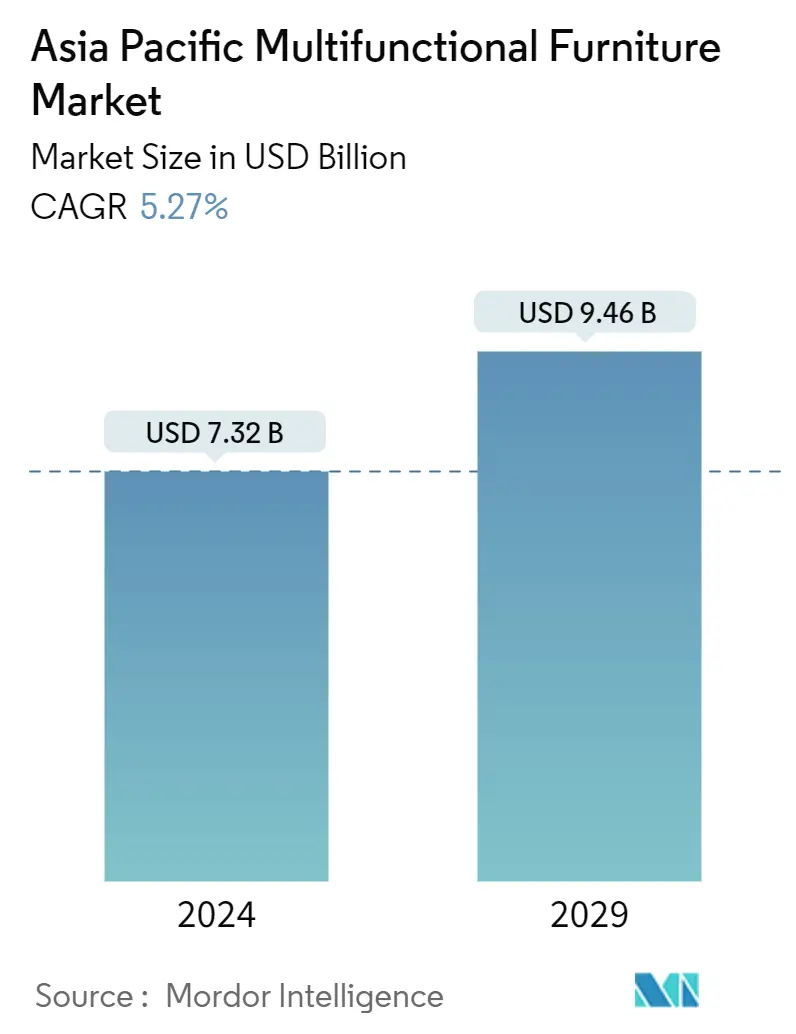Market Size of Asia Pacific Multifunctional Furniture Industry

| Study Period | 2020-2029 |
| Base Year For Estimation | 2023 |
| Market Size (2024) | USD 7.32 Billion |
| Market Size (2029) | USD 9.46 Billion |
| CAGR (2024 - 2029) | 5.27 % |
| Market Concentration | Low |
Major Players
*Disclaimer: Major Players sorted in no particular order |
Asia Pacific Multifunctional Furniture Market Analysis
The Asia Pacific Multifunctional Furniture Market size is estimated at USD 7.32 billion in 2024, and is expected to reach USD 9.46 billion by 2029, growing at a CAGR of 5.27% during the forecast period (2024-2029).
- The Asia-Pacific multifunctional furniture market is experiencing significant growth and popularity. One of the key factors contributing to its growth is the increasing urbanization in the region. As cities become more crowded and living spaces smaller, people seek furniture that can serve multiple purposes and make the most of limited space.
- Multifunctional furniture provides practical solutions by combining functionality, style, and space-saving features. Additionally, changing lifestyles and the need for flexibility have fueled the demand for multifunctional furniture. This market trend has led to various innovative designs and options for consumers. As a result, the market is witnessing a surge in local and international manufacturers catering to consumers' diverse needs and preferences in the Asia-Pacific region.
- In the past few years, the e-commerce furniture market in the Asia Pacific region has experienced significant growth. The variety of choices and discounted pricing offered by online furniture retailers have attracted regional consumers.
Asia Pacific Multifunctional Furniture Industry Segmentation
A piece of furniture having many combined uses is called multifunctional furniture.
The multifunctional furniture market is segmented by product type, which includes chairs, tables, windows, doors, and other product types. By distribution channels, including online markets, mass merchandisers, supermarkets, hypermarkets, and other distribution channels. By application, including commercial and residential, and by geography, including India, China, Japan, and the rest of Asia-Pacific.
The report offers market size and forecasts for the Asia-Pacific multifunctional furniture market in terms of revenue (USD) for all the above segments.
| By Product Type | |
| Chairs | |
| Tables | |
| Windows | |
| Doors | |
| Other Product Types |
| By Distribution Channel | |
| Mass Merchandisers | |
| Online | |
| Supermarket | |
| Hyper Market | |
| Other Distribution Channels |
| By Application | |
| Commercial | |
| Residential |
| By Geography | |
| India | |
| China | |
| Japan | |
| Rest of Asia-Pacific |
Asia Pacific Multifunctional Furniture Market Size Summary
The Asia Pacific multifunctional furniture market is experiencing robust growth, driven by increasing urbanization and the need for space-efficient solutions. As urban areas become more densely populated, consumers are seeking furniture that maximizes functionality while minimizing space usage. This trend is further fueled by evolving lifestyles that demand flexibility and adaptability in home furnishings. The market is characterized by a surge in innovative designs and a diverse range of options, catering to the varied preferences of consumers across the region. The presence of both local and international manufacturers is expanding, as they strive to meet the growing demand for multifunctional furniture that combines practicality with style.
The e-commerce sector has significantly contributed to the market's expansion, offering consumers a convenient shopping experience with a wide array of choices and competitive pricing. As internet access continues to improve across Asia, more consumers are turning to online platforms for their furniture purchases, further broadening the market's reach. Major e-commerce marketplaces like Alibaba and Lazada have enhanced their furniture offerings, attracting both established brands and smaller retailers. This has resulted in a fragmented market landscape, with key players such as Walmart, Godrej Interio, and IKEA leveraging their extensive networks to capture a larger share of the market. Recent expansions by companies like Godrej Interio and Kave Home highlight the ongoing growth and strategic developments within the region's multifunctional furniture market.
Asia Pacific Multifunctional Furniture Market Size - Table of Contents
-
1. MARKET DYNAMICS AND INSIGHTS
-
1.1 Market Overview
-
1.2 Market Drivers
-
1.2.1 Increasing Demand for Space Saving Solutions in Smaller Living Spaces
-
-
1.3 Market Restraints
-
1.3.1 High Cost Compared to Traditional Furniture is Restraining the Market
-
-
1.4 Market Opportunities
-
1.4.1 Growing Demand for Eco-friendly Multifunctional Furniture is Creating an Opportunity
-
-
1.5 Industry Attractiveness - Porter's Five Forces Analysis
-
1.5.1 Threat of New Entrants
-
1.5.2 Bargaining Power of Buyers
-
1.5.3 Bargaining Power of Suppliers
-
1.5.4 Threat of Substitutes
-
1.5.5 Intensity of Competitive Rivalry
-
-
1.6 Insights of Technology Advancements in the Market
-
1.7 Impact of COVID-19 on the Market
-
-
2. MARKET SEGMENTATION
-
2.1 By Product Type
-
2.1.1 Chairs
-
2.1.2 Tables
-
2.1.3 Windows
-
2.1.4 Doors
-
2.1.5 Other Product Types
-
-
2.2 By Distribution Channel
-
2.2.1 Mass Merchandisers
-
2.2.2 Online
-
2.2.3 Supermarket
-
2.2.4 Hyper Market
-
2.2.5 Other Distribution Channels
-
-
2.3 By Application
-
2.3.1 Commercial
-
2.3.2 Residential
-
-
2.4 By Geography
-
2.4.1 India
-
2.4.2 China
-
2.4.3 Japan
-
2.4.4 Rest of Asia-Pacific
-
-
Asia Pacific Multifunctional Furniture Market Size FAQs
How big is the Asia Pacific Multifunctional Furniture Market?
The Asia Pacific Multifunctional Furniture Market size is expected to reach USD 7.32 billion in 2024 and grow at a CAGR of 5.27% to reach USD 9.46 billion by 2029.
What is the current Asia Pacific Multifunctional Furniture Market size?
In 2024, the Asia Pacific Multifunctional Furniture Market size is expected to reach USD 7.32 billion.

